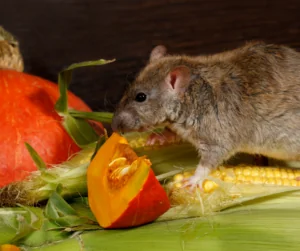
One of the most aggravating things to deal with in the Spring as a homeowner is the presence of pests getting inside your pantry. You may think your food is safe, but unless they are in sealed, airtight containers, your dry food can be left vulnerable to pests like rats, mice, beetles, moths and silverfish. However, by taking the proper precautions, you can prevent a full on infestation and protect your pantry this Spring.
Rodents in Your Pantry

Unfortunately, food kept in soft paper or plastic containers just aren’t safe from rodents. Their powerful teeth can gnaw straight through most packages and bags that prepackaged food is kept in. Don’t store food in the original package, instead store it inside reusable containers with an airtight seal. Another important part of keeping mice away from your pantry is cleaning up any spills immediately. Any crumbs or sticky residue left behind can attract mice. Always take out your kitchen garbage at least daily if not more, using a covered trash can will also help deter mice from getting into your kitchen. However, rodents are not the only pest you might have in your pantry this Spring, you might also be dealing with insects like moths, beetles and silverfish
Common Pantry Insect Pests
Common pantry insect pests have long been a burden on mankind, and it is said that modern sanitation and storage systems for stored food would not be in place without these pests. These stored product pests are separated into two sub categories: primary and secondary. Primary pests attack undamaged whole grains/organics and lay larvae that develop internally then emerge to further infest the area. Secondary pests attack damaged and broken grains/organics, feeding off dust and other byproducts. The three main types of pest you will find in your pantry are moths, beetles and occasionally silverfish.
Moths

Beetles
Beetles are another common type of stored product pest. Red flour beetles can live up to 3 years, with the females laying 200-450 eggs per lifetime. Red flour beetles will deposit their eggs in food, with the larvae emerging 5-12 days later. Red flour beetles attack flour, cereals, biscuits, beans, nuts, mixes, chocolate, pet food, bird seed and even pharmaceuticals. Drugstore beetles are an older specimen, and one of the hardest to catch prior to an issue. The female can lay up to 75 eggs at once. Drugstore beetles feed on flour, sweets, cereal, rice, oats, bread, pasta, pet food, barley, bird and grass seed. Cigarette beetles are a similar looking beetle that prefers to feed on tobacco, but it will also feed on spices, dried fruit, cereals, flour and some pet foods. Sawtoothed grain beetles can lay between 43-285 eggs in their lifespan of 6-10 months. Their larvae account for most of the damage they do to food sources, as the larvae use broken pieces of grain to form their cocoons. Sawtoothed grain beetles feed on grains, grain products, dried fruit, bran, oats, rice, nuts, chocolate, tobacco and pasta.
Silverfish
Silverfish are another type of stored product pest that are slightly less common in pantries, depending on what your pantry contains. Silverfish feed on products containing a type of carbohydrate called Polysaccharides. Some products with polysaccharides include book bindings, carpet, clothing, paper, coffee, cotton, linen and glue. Silverfish lay less than 100 eggs within their 3 year lifespan, and can actually live more than a year without food if a water source is available. Silverfish are one of the few insects that molt well after adulthood.
Pantry Pest Prevention

Pantry Pest Control
If you have an infestation of mice, beetles, moths, silverfish or more, then your best course of action is to contact a licensed pest control company like Summit Pest Control. Throwing away all contaminated food and inspecting the remaining food to make sure it has not been infiltrated by the pests is a good first start. A pest control technician can inspect your property thoroughly, provide you with professional grade solutions to eliminate the pests for good, provide exclusions on your home if necessary, and provide you with tips and solutions on preventing pantry pests in the future. If you need pantry pest control in the Fairfax, Alexandria, Arlington or Fredericksburg areas, contact Summit Pest Control today at 703-884-2124 or fill out a contact form.












